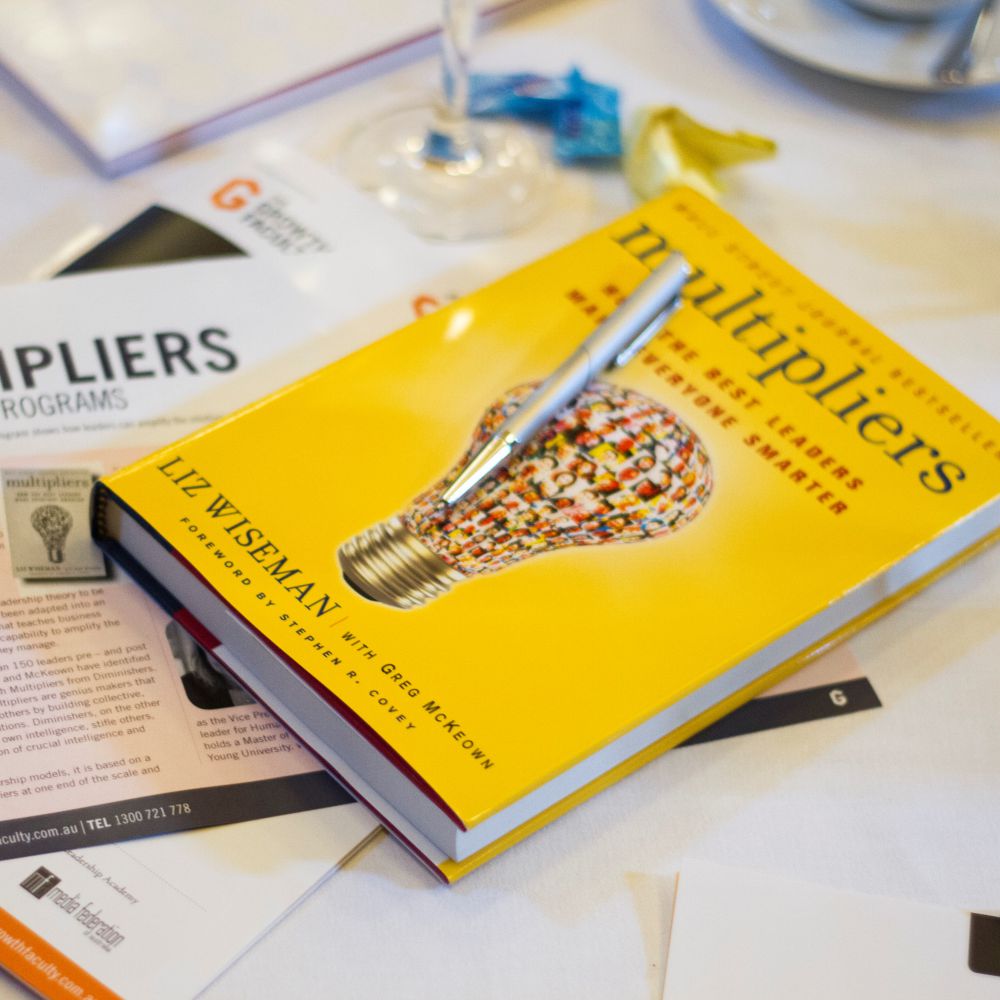Skills from Leadership Masterclass to inspire your team to great results

Some leaders inspire teams to get superior results.
They’re known as “Multipliers” – a term coined by global speaker Liz Wiseman in her book of the same name.
The Growth Faculty this week hosted Part 2 of Our Time for Transformation masterclass “Multipliers - Unlock Your Team’s Potential” with Multipliers master practitioner Deborah Keep (pictured).
Later in this Masterclass summary, we’ll look more closely at 4 specific behaviours of multipliers:
· Challenger
· Investor
· Liberator
· Talent Magnet.
Recapping Multiplier vs Diminisher leadership
First, what is the benefit of being a Multiplier?
Deb says data shows employees use up to 90% of their intelligence when working for a “Multiplier” leader but only around 40% when working for a “Diminisher”.
Multiplier Behaviours (They behave as if people are smart and will figure it out):
· Talent magnet – Attract and optimise talent.
· Liberator – Create space for best thinking and demand best work.
· Challenger – Extend stretch challenges.
· Debate maker – Drive sound sound decisions through rigorous debate.
· Investor – Instill ownership and accountability.
Diminisher Behaviours (They behave as if ‘people won’t figure it out without me’)
· Empire builder – they hoard and underutilise talent.
· Tyrant – they create stress that stops thinking.
· Know-it-all – they tell people what to do.
· Decision Maker – they decide (then ask for debate).
· Micromanager - they're always over your shoulder.
The “Accidental Diminisher” leads with the best of intentions but accidentally shuts down intelligence. Their people feel stifled, depleted, toxic, or overworked but underutilized.
· Idea fountain – Leader shares too many new ideas all the time.
· Always on – Leader is gregarious and exhausting.
· Rescuer – Leader fixes things and so others feel helpless.
· Pacesetter – Leader sets a cracking pace. People can’t keep up.
· Rapid responder – Leader jumps to immediate response. Team members sit back.
· Optimist – Leader is all “ra, ra, we can do this.” Team sees the leader as out of touch.
· Protector – Leader too nice so employees don’t grow.
· Strategist – Leader expects followers but excludes others from the big thinking.
· Perfectionist – Employees feel they’re never good enough.
The Value Question Ladder
The trait of a multiplier is “intellectual curiosity.” So, the core skill of a multiplier is to ask more questions.
Try to make a habit of asking questions higher up the value question ladder: CLOSED > OPEN> LEADING> GUIDING> DISCOVERY> CHALLENGE.
Especially try:
· DISCOVERY – questions no-one has an answer to yet
· CHALLENGE – where you question prevailing assumptions.
TIP: Develop a set of back pocket questions.
Library of suggested questions
Masterclass delegates suggested the following questions to try at work and home:
· How confident are you that your assumptions are accurate?
· What biases do you think are at play with this approach?
· Why do we do it this way? Is there a better way?
· What are you afraid of?
· The 5 whys (literally WHY, WHY, WHY, WHY, WHY), to get to the REAL reason
· What would need to be true, for this to become reality?
· What is something that we do that is stupid?
· What would happen if we did try it? (when someone is worried)
· How COULD we?
· What are we missing?
· Do you think that or know that?
· If we can’t, how can we?
· Whose voices are we not hearing?
· What would you do if you had no other choice?
· If you say yes to this, what are you saying no to?
· What would you do if budget wasn’t an issue?
· What if this were your entire job?
Extreme question challenge – Try to only ask questions in your next meeting.
Okay, so let’s look at 4 types of Multipliers.
First up, the CHALLENGER behaviour.

The pole vaulter who became a Challenger at Gymboree
At the age of 33, former pole vaulter Matt McCauley took over as CEO of Gymboree, at a time when the shares were valued at 69 cents.
He told the board he would lift the share price to $1 a share.
Using his knowledge of goal-setting in competitive pole vaulting, he immediately implemented a culture of setting stretch goals in his new company. He asked every team to create their own “Mission Impossible goal.”
A year later the share price hit the $1.19 mark. He created 72% improvement within 2 years. Within 4 years he’d achieved a 5-fold increase in the share price.
· Lesson: Challengers get rid of boring goals and instead set ENGAGING CHALLENGES.
· Example: “We need to increase operational efficiencies to improve staff productivity” to “What admin work can we eliminate or streamline to be able to send home everyone one hour earlier?”
Creating a stretch challenge.
Identify the challenge.
· What is the hard thing your organisation might be capable of? Instead of mundane, make it an intriguing puzzle.
Scope a first step.
· What’s an early win within reach? What will go viral?
Make it clear and compelling.
· What question must get answered – you want it to be vivid.
Getting started:
· Try turning a goal into a question.
· How do we……………..with only………………….while………………………………by……………………….?
Become an investor in your people. Hand the pen back.
McKinsey executive Jae Choi of South Korea was watching his team stall on a project.
Project leader Hyunjee is at the whiteboard but the team is clearly stuck. It’s late and she’s looking to her leader for help. Jae can see a possible way forward. He takes the whiteboard marker and lists some emerging themes, encouraging the team to view the facts from a different angle.
But, to the surprise of his team, he hands the whiteboard marker back to the team leader. “Okay, looks like we’ve got a new line of thinking to run with. Lets see what you can do with this,” he finishes.
Investor vs Micromanager
Practice #1 - Give it back:
1. Recognise the pull to rescue and take over
2. Offer essential help
3. Return ownership
(Level 1. Help but don’t take over. Level 2. Help but remind them that they are in charge. Level 3: Help by coaching instead of doing).
Practice #2 – Give 51% of the vote.
· Say you are still there for help if needed, but the team or manager has the 51% of the vote (to develop trust, ownership and accountability).
Take Action:
1. Create an engaging challenge.
2. Give 51% of the vote
3. Give the pen back (help, but don’t take over).
Be a Liberator: The less often I speak, the more often I will be heard
In Multipliers speak, the Liberator creates space for best thinking versus the Tyrant who creates stress that stops thinking.
The executives with the best presence are restrained. When they speak, everyone listens. They know when to be big and when to be small.
Practice #1: Play fewer chips. Try giving yourself a budget of poker chips for a meeting. Maybe it’s 5, maybe it’s 2. Use them wisely and leave the rest of the space for others to contribute.
Practice #2: Making space for mistakes. Multipliers talk about their own mistakes first.
· Identify where it’s NOT OK to fail.
· Discuss, debate, decide.
· Summarise where it’s NOT OK to fail.
Practice #3. To create a safe space, talk up your own mistakes (what did you do, where were you wrong, what did you learn)
· Identify big mistakes in your career.
Talent Magnet – do you want to be a genius or genius maker?
The Talent Magnet utilises people at their highest point of contribution. They deliberately hunt for native genius in their people, and unleash it to great effect.
Patrick Lencioni has developed a tool to discover native genius in leaders and their teams. But, you can get a sense of a person’s genius by asking these questions.
What do they do:
1. Better than anything else they do?
2. Better than people around them?
3. Without effort?
4. Without being asked?
5. Readily without pay?
6. At work and at home?
Action to unleash the genius:
· Identify someone’s native genius.
· Talk with them about it.
· Label it.
· Put it to use.
Summary
Some leaders make us better and smarter.
Via very thoughtful behaviours, they create a safe and joyful workplace, and in doing so, unleash the potential from every member of their team.
Multiplier behaviours are the secret sauce to increasing the capability and capacity of the team you have now.
So don't wait to start your own Multiplier journey.
For a full overview, read Multipliers by Liz Wiseman with Greg McKeown.
If you'd like to increase your professional development why not consider becoming a member of The Growth Faculty? One membership, unlimited access to 30 live virtual Time For Transformation masterclasses and the best live virtual events - PLUS year-round leadership content On Demand with videos, podcasts and book summaries. Join a community of knowledge seekers who are inspired by the best. Access $4350+ value for just $398 AUD. See who's up next.


 Australia
Australia
 European Union
European Union
 New Zealand
New Zealand
 United Kingdom
United Kingdom
 United States
United States
 Singapore
Singapore

